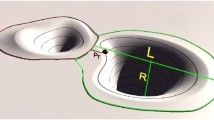Abstract
Unsustainable growth is typical of systems that rely on a finite pool of non-renewable resources that are tapped until they are depleted. The decrease in resource availability eventually leads these systems to a decline. Here we investigate the dynamics of systems that exhibit unsustainable growth and are prone to a collapse to an alternative (“degraded”) state. For these systems the possible imminent occurrence of a collapse is difficult to avert because they keep growing as they approach the transition point. It is therefore important to identify some early warning signs that can be used to predict whether the system is approaching a critical and likely irreversible transition to an undesired and degraded state. This study evaluates whether existing theories of precursors of phase transitions based on the critical slowing down phenomenon are applicable as leading indicators of state shift in unsustainable growth dynamics. It is found that such indicators fail to serve as reliable early warning signs of the system’s collapse.




Similar content being viewed by others
References
Boerlijst, M. C., Oudman, T., & de Roos, A. M. (2013). Catastrophic collapse can occur without early warning: examples of silent catastrophes in structured ecological models. PLoS ONE, 8(4), 1–6.
Brock, W. A., & Carpenter, S. R. (2006). Variance as a leading indicator of regime shift in ecosystem services. Ecol. Soc., 11(2), 9.
Carpenter, S. R. (2005). Eutrophication of aquatic ecosystems: bistability and soil phosphorus. Proc. Natl. Acad. Sci. USA, 102, 10002–10005.
Carpenter, S. R., & Brock, W. A. (2006). Rising variance: a leading indicator of ecological transition. Ecol. Lett., 9, 311–318.
Carpenter, S. R., Cole, J. J., Pace, M. L., Batt, R., Brock, W. A., Cline, T., Coloso, J., Hodgson, J. R., Kitchell, J. F., Seekell, D. A., Smith, L., & Weidel, B. (2011). Early warnings of regime shifts: a whole-ecosystem experiment. Science, 332, 1079–1082.
Dakos, V., Scheffer, M., van Nes, E. H., Brovkin, V., Petoukhov, V., & Held, H. H. (2008). Slowing down as an early warning signal for abrupt climate change. Proc. Natl. Acad. Sci. USA, 105, 14308–14312.
Dakos, V., van Nes, E. H., D’Odorico, P., & Scheffer, M. (2012). How robust are variance and autocorrelation as early-warning signals for critical transitions? Ecology, 93(2), 264–271.
D’Odorico, P., Ridolfi, L., & Laio, F. (2013). Precursors of state transitions in stochastic systems with delay. Theor. Ecol.. doi:10.1007/s12080-013-0188-2.
Gardiner, C. W. (1986). Handbook of stochastic methods. Berlin: Springer.
Horsthemke, W., & Lefever, R. (1984). Noise-induced transitions: theory and applications in physics, chemistry, and biology. Berlin: Springer.
Scheffer, M. (2009). Critical transitions in nature and society. Princeton: Princeton University Press.
Scheffer, M., Carpenter, S. R., Lenton, T. M., Bascompte, J., Brock, W., Dakos, V., van de Koppel, J., & van de Leemput, I. A. (2012). Anticipating critical transitions. Science, 338, 344.
Strogartz, S. H. (1994). Nonlinear dynamics and chaos with applications to physics, biology, chemistry, and engineering. Reading: Perseus Books.
van Nes, E. H., & Scheffer, M. (2007). Slow recovery from perturbations as a generic indicator of a nearby catastrophic shift. Am. Nat., 169, 738747.
Walker, B. H., & Salt, D. (2006). Resilience thinking. Washington: Island Press.
Walker, B. H., Ludwig, D., Holling, C. S., & Peterman, R. M. (1981). Stability of semi-arid savanna grazing systems. J. Ecol., 69, 473–498. doi:10.2307/2259679.
Author information
Authors and Affiliations
Corresponding author
Rights and permissions
About this article
Cite this article
Ridolfi, L., D’Odorico, P. & Laio, F. Indicators of Collapse in Systems Undergoing Unsustainable Growth. Bull Math Biol 77, 339–347 (2015). https://doi.org/10.1007/s11538-013-9922-6
Received:
Accepted:
Published:
Issue Date:
DOI: https://doi.org/10.1007/s11538-013-9922-6




